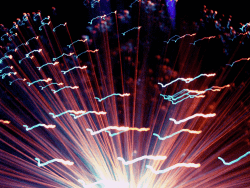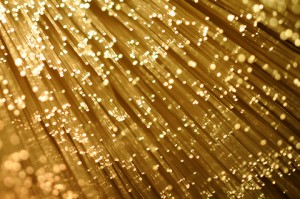Fiber-Optic Outdoor Lighting: Using Fiber Optics for Outdoor Decoration
Fiber optic outdoor lighting provides a number of options for underwater and decorative lighting in your yard.
Fiber optic outdoor lighting provides a completely unique sort of lighting for your pool, deck, yard or any other area outside of your home. The lighting is unique both in terms of its flexibility, water-friendliness and ability to change color. This makes it especially suited to many sorts of decorative lighting. Fiber optic lighting works by having a light source called an “illuminator” at one end of the fiber optic cable. The light then transfers through the cable to the other end. Either the cable can release the light all the way along its length, so that the entire cable becomes a source of light, or the cable can release the light simply at the far end, where all the light can be directed into a fixture.
The upshot of all of this is that the cable itself is completely free of electrical current. All it does is carry light. It doesn’t produce it. This means that you have a cable that can be completely submersed in water or left out in the rain without any fear of electrocution. In addition, the cables are far more flexible than any other lamp. Neon, for example, needs to be set in position at the manufacturer, but fiber optic light is simply flexible.
There are some downsides to fiber optic outdoor lighting, however, that you should be aware of. Until recently, fiber optics was the “darling” of the lighting industry because of all of the new uses to which it could be put. However, no one was able to make fiber optics bright enough to serve as much more than decoration without making them prohibitively expensive. As LED light fixtures became more and more flexible, fiber optics fell more and more out of use.Nonetheless, there are still a number of decorative uses for fiber optic outdoor lighting that can never be replaced by LEDs. I will discuss these uses below.
Pool Lighting
One of the most common uses of fiber optic outdoor lighting is as pool lighting. Fiber optics are ideal for this sort of lighting for two primary reasons. First, the light source can be housed far away from the water, virtually eliminating any risk of electrocution. Second, they are flexible, allowing people to place fiber optic lighting all the way around the edge of their curved pools.

Fiber optics are excellent way to frame the edge of your pool. Photo courtesy of blmurch
Second, you can have a custom fiber optic lighting job done. In this case, a specialist will measure your pool for you, determine just how much fiber optic cable you’ll need to circle your entire pool Then, the specialist will either have it installed for you or can provide you with directions for installing it yourself. The lighting is usually installed around the edge of your pool, just under the lip.
Don’t restrict yourself simply to the edge of the pool, however. Fiber optic lighting can be put in a number of different places. For example, it can be used to mark off stairs going into the water of your pool. You can either place the fiber optic lights under each step or even on a diagonal down the sides of each stairway. In addition, you can place lights on the bottom of your pool to create unique decorations. You can put shapes or, if you use cables that release light only on the end, what look like twinkling stars. The flexibility of fiber optic outdoor lighting restricts your options only to your imagination.
Safety warning: Fiber optic lights are not sufficiently bright for safe nighttime swimming. Other sources of light should also be used.
Fountain Lighting
Another attractive use of fiber optic outdoor lighting is fountain lighting. Just like pools, one option is to use your fiber optic lighting on the edge of the pool at the base of the fountain. This provides the pool with a crisp color that permeates the water. This lighting can be done either using a kit or as a custom job, just like a pool.

Fiber optics can change the color of water as it falls. Photo courtesy of Symic
This has a very interesting effect. The light from the fiber optics actually lights the water as it falls. In some ways like fiber optic cables themselves, water will actually carry light through itself, so that all of your falling water will actually appear like it is colored water. You can either use this to create a natural blue water at night or do something more daring like red, yellow or green.
Fiber optics even has the option of changing colors. Many illuminators allow you to use a filter to color the light before it reaches the fiber optic cable. This means you can have a fountain where the water slowly changes color as it falls. This can be quite a striking effect, but be careful not to overdo it, as it could become garish of the transitions are too harsh. Go from related color to related color, like from blue to purple not from blue to red, and don’t transition too quickly.
Other Decorations
The sheer flexibility of fiber optic outdoor lighting makes it well suited to many other forms of decorative lighting. Because fiber optic lighting can transfer light entirely to the end of the cable, lighting fixtures can be connected to the end and the light can be concentrated in a single spot. This has led to many different innovations in the development of fiber optic outdoor lighting.

Fiber optics can be used for creating attractive works of art made out of sparkle. Image courtesy of kainet
Information Path Lighting: Another common use of fiber optic lighting is to put a strip of illuminated fiber optic cable along the edge of a path or stairway. This lets people know where the edges of the path are. The lights aren’t bright enough to actually illuminate the path, so be sure to have some additional lights so that people won’t trip over any obstructions.
Pavers: Pavers are illuminated pavestones that provide excellent decoration and a very modern feel, perhaps originally inspired by the move Saturday Night Fever. While pavers are often made using LEDs, that requires solar or electric power that might be unsightly or difficult to install. An alternative is to use fiber optic tubing to light the pavers and make the pathway sparkle.
Art: Another option is to simply use some fiber optic artwork in your yard, produced by an artist. There are many artists who work in the fiber optic medium, as it allows them to use subtle points or flexible lines of illumination. Consider such a work of art as an alternative to a statue if you do a great deal of entertaining at night.
Putting It All Together
Fiber optic outdoor lighting may no longer be the golden child of lighting design, but what it does, it does better than anyone:
- Fiber optics are flexible, waterproof and easily change color.
- They make great lights for inside of pools.
- They can illuminate the water in fountains for a unique effect.
- They can be used for a wide variety of other outdoor decorations.
Fiber optics will likely never go away as a form of decorative lighting. Their ability to separate electricity from light is unparalleled and leads to freedom in design.
Back from Fiber-Optic Outdoor Lighting to Outdoor Lighting Ideas
Back from Fiber-Optic Outdoor Lighting to Home Lighting Tips
